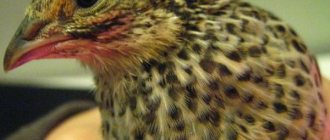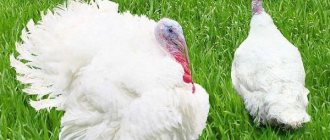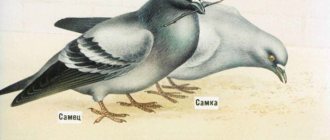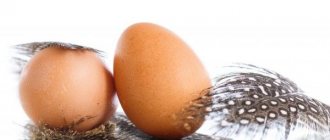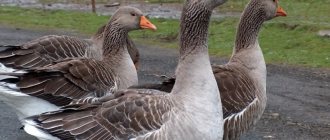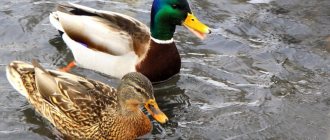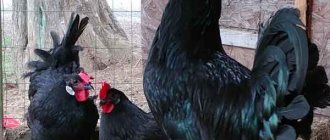Poultry farming » Guinea fowl
0
1303
Article rating
Kira Stoletova
Guinea fowl are a unique breed of birds, originally from Italy, famous throughout the world for their undemanding, tasty, dietary meat and large, healthy eggs with a strong shell, which extends the shelf life of products to six months. Birds, which have won the hearts of millions, have become popular farm animals. In this regard, the question has become urgent for breeders and poultry farmers (especially beginners): How to distinguish a female from a male guinea fowl?
The difference between a female and a male guinea fowl
Bird size and weight
Many farmers argue that sex is determined by the body weight and size of birds. But opinions differ significantly. Some believe that guinea fowl are the only poultry in which the females are larger than the males; other breeders do not agree with this.
In fact, up to 4 months, the female is much smaller in size than the male. But after the guinea fowl overcomes this age limit, especially during the egg-laying period, it begins to rapidly gain weight. That’s when she becomes larger than the Caesar, her body weight increases by 20%.
Why do you need to differentiate birds by gender?
Birds of both sexes are kept together for constant reproduction of offspring - it is enough to buy a batch of birds once and then independently engage in “selection”.
Expert opinion
Novoselova Sofya Ivanovna
Farmer. 20 years of experience.
Ask a Question
Guinea fowl, like most domestic birds, are polygamous - the presence of one male is sufficient to successfully fertilize five females. You can, of course, introduce more males, but then egg production will suffer and quarrels over “dames” will certainly begin.
Another important aspect is that a cunning breeder can sell many extra males to an inexperienced poultry farmer, which will ruin the business in the bud.
Beak shape
It is quite possible to identify a female or a male by looking at the shape of the beak. Females have graceful, small, neat beaks with non-bulging nostrils. The beak of females is reddish-orange. There is no tuberosity on the front part, the beak smoothly passes into the head.
It's a little different for males. With age, the beak of “boys” becomes larger in size and especially stands out when looking at the bird. The base of the beak is bright red, almost bloody. The nostrils are quite large and noticeable.
Below is a table with comparative characteristics of the appearance of the beak and part of the head in birds:
| Female | Male |
|
|
These distinctive features in the appearance of the beak and nostrils in males and females become noticeable when the young are 4-5 months old.
Method No. 5 - by plumage
Igor Nikolaev
auto RU
The color of the down of newborn chicks is different from the plumage of adult birds. Beginners in poultry farming are always confused by the color of the body down of young animals. They are frightened that they did not acquire guinea fowl, but another type of bird. Juvenile feathers appear in chickens at 4 months. It changes to adult plumage when molting at 12-14 months.
Each breed of bird has its own individual plumage color, but even beginners know how to distinguish guinea fowl by their body covering. They are modest and try not to be conspicuous. This is also facilitated by the intensity of the color of the feather. It is dim, unsaturated, pale:
- Layers of the gray-mottled breed have a blue tint. Cockerels have bright plumage closer to black;
- The color of the Zagorsk white-breasted breed is also different. The girls' feathers seem to be covered with a silver haze. In boys they are bright gray;
- Males of the vulture domestic breed have all shades of blue in their body cover. In females the colors are muted.
It is impossible to identify only individuals of the Volga breed by plumage. It is white in both male and female individuals. There are no differences in birds of the Siberian white breed. There are crosses with cream and pearl coats. But it is the same for both females and males.
Feather color and length
Until one and a half months of age, it is quite difficult to determine the sex of a bird by feathers, because visually the animals look the same. But adult individuals vary in color, which makes it possible to determine the sex of the animal. For example, white Siberian guinea fowl and cream-colored females predominate in darker plumage, while males are somewhat lighter in color. Sometimes it is much easier to find a male with just one glance - he has completely white plumage.
To determine sex, many farmers use a method related to the inheritance of plumage color. If you believe him, then females tend to inherit the color of cesars and vice versa, males predominate in the same color as their female mothers. Due to this, it is sometimes possible to distinguish guinea fowl by cross-coloration. But this method is considered quite complex and more suitable for experienced farmers.
It was also noted that the female’s feathers grow faster than the male’s. That is, birds whose plumage appears earlier are crossed with guinea pigs that feather later. The result is a breed of guinea fowl in which the females have more long flight feathers than all the others. Moreover, males have exactly the same length of feathers.
Ridge location
The comb, or rather its location, will help you find out whether the farmer is a guinea fowl or a guinea fowl. This method requires special care. How to identify males by their comb:
- it is slightly raised from the base of the head;
- does not stand straight, but slightly in a bent position;
- has a larger size.
In the video, Ivan Serba, who breeds guinea fowl, will tell you from his own experience how to distinguish a female from a male. A clear example of the location of the comb and the shape of the earrings will also be shown:
Why do you need to know the gender of guinea fowls?
The gender of guinea fowl will help you correctly form the tribe of birds you have. There are five times as many females per male. It turns out that for a herd of 20 females, only four males are needed.
It is important to determine the gender of guinea fowl chicks before purchasing them.
Of course, in the poultry business, guinea fowl are considered the most valuable because they produce eggs from which the next generation is born. So the process of breeding birds goes in a circle, bringing constant profit.
Don’t worry, it’s not difficult for such a small number of males to fertilize five times as many females. In flocks of farm birds, polygamy is inherent by nature and selection, so the males are ready for exploits.
Consequently, if you take the word of a seller offering guinea fowl chicks for sale, but he turns out to be a deceiver and sells you males at the price of females, you will not only lose money at the purchasing stage, but also ruin the entire further breeding process.
Video - How to distinguish a female guinea fowl from a male
Voice
Birds have a rather melodic loud voice. Because of this feature, not every farmer wants to keep guinea fowl. Males tend to “crackle” and “trill.” You can distinguish the female by her softer voice; girls do not chatter.
If it is difficult to understand how a female guinea fowl screams, in the video you can clearly hear the bird’s voice, and also understand how it behaves during the “conversation”:
What kind of bird is this
Although there are several species of guinea fowl, or royal birds, as they are also called, on the planet, man has managed to domesticate only one species - the common gray guinea fowl. Scientists believe that the homeland of these birds was the island of Madagascar, as well as certain areas of Africa.
The main characteristics of this type of poultry are as follows:
- medium sized body;
- gray uniform color of the entire body;
- fleshy growth on the back of the head;
- earrings at the bottom of the beak.
This bird can live in an ordinary summer cottage or garden plot. Female guinea fowl lay eggs, and, as practice shows, for many farmers who breed them, this alone is the main distinguishing feature of the sex.
Habits
Girls and boys behave differently, and their behavioral characteristics can differ significantly. Females behave modestly, their tail is located downwards, their head is always in a natural position. Guinea fowl are somewhat fussy, constantly looking for food. They like to hide in secluded corners.
Males always show themselves as strong individuals. Their tail is curled high up. Their head is raised, they constantly look to the sides. There is pride and superiority in all movements. He is “the ruler, the master of the situation”, looks at the females condescendingly.
Primary sexual characteristics
It will be possible to determine male and female with a 100% guarantee based on the structure of the genitalia of birds. After examining them, the farmer will be able to understand what gender the animal is in front of him. The advantage of this method is that with its help sex determination is possible at the age of one day.
Experienced poultry farmers know that from the day of birth until 1.5-2 months, birds are practically no different in appearance and behavior.
In this case, gender characteristics are determined by the structure of the genitals; a girl has a loop, a boy has a penis.
Follow these instructions:
- Carefully lure the bird towards you and pick it up. Lightly stroke the back to calm it down, because guinea fowl are considered overly timid birds, and contact with a person can greatly frighten the animal. A frightened guinea fowl begins to shrink with its whole body, which may cause difficulties in stretching the cloaca. The bird will feel severe pain or be completely traumatized.
- Only light stroking for a few minutes can calm the animal. If it is a male, then such touches will cause blood flow to the cloaca - the penis will open, which will be impossible not to notice.
- When the bird calms down, turn it over on its back for better visibility of the anus. You need to hold the guinea fowl with one hand, and with the other, carefully push away the interfering feathers and stretch its cloaca. Be sure to perform the procedure with gloves.
- A thorough examination begins: the “boy” has a pink penis, somewhat reminiscent of a tubercle; The “girl” inside the passage has no differences, she has a pink loop.
The sex of chicks should be determined before purchase so that the farmer can know how many females to buy per male. This is important in poultry breeding and, accordingly, has an impact on further profits.
When purchasing, you should not trust the seller; he may claim that he is selling females, but in reality they may be males. You won’t be able to get your money back, but what’s worse is that all future business will be ruined due to the lack of females in the herd. Therefore, you should learn to distinguish females from males so as not to become a victim of unscrupulous sellers.
It is recommended to perform all the methods described above in a comprehensive manner. Over time, the poultry farmer will gain experience and learn to distinguish guinea fowl from guinea fowl quickly and easily.
How to distinguish a female from a male?
Knowing a number of characteristic signs, it is still possible to distinguish guinea fowl. There are many ways to distinguish the sex of individuals.
To size
Unlike other types of poultry, in guinea fowl the male does not exceed the female in size. It is about 20% smaller than her. Therefore, it is logical to assume that smaller individuals are males. But this method of determination does not provide a complete guarantee. In addition to gender, other factors influence the size of a bird.
According to the shape of the beak
Despite the fact that guinea fowl look almost the same, the shape of the beak and the position of the head will help determine the sex.
Females have a thin and sharp beak. The beak of the Caesars is massive.
At the base of the beak, these birds have an area of thickened skin, the so-called. cere. In females it is less pronounced, pink in color, in males it is overgrown, lumpy and bright red.
The cere in females of the second and third years of life grows and becomes rough. Therefore, this method of determining sex is only suitable for young individuals.
If you hold a guinea fowl in your hands, individuals of different sexes will hold their heads differently. The female will hold her head upright, while the guinea will lower and extend her neck.
By ridge location
Sex differences in guinea fowl can be determined by taking a closer look at the shape and location of the scallop.
In the case of the Caesars, the crest is extended upward and bent back. The female has a neat crest, slightly rising above her head. But such differences appear only in a three-month-old bird.
According to the shape and color of the earrings
As with the waxwing, the male's earrings are more fleshy and have a bright bloody color. Females have small earrings that fit close to the head.
It is possible to distinguish a male from a female by the shape and color of the earrings only in the first year of keeping.
On the left is a male with a rich, massive cere. On the right is a female with a paler and more compact cere.
With age, the earrings of females become coarse and darken.
By voice
Only an experienced poultry breeder can determine by its voice what gender the bird in front of you is. To do this, you should spend a lot of time with guinea fowls and listen to their singing, because they are noisy birds. They make loud and frequent noise.
When frightened, individuals of different sexes make the same sound, reminiscent of a chirping, but they sing differently, the female makes melodious sounds, the songs of the males are characterized by crackling and intermittency.
The female's singing consists of two syllables, the second of which is longer. The singing of the Caesars is intermittent, consisting of one syllable. The difficulty is that females imitate males, and in this case it is difficult to determine gender by voice.
By habits
You should take a closer look at guinea fowls to determine the sex based on behavioral characteristics.
The Caesars behave importantly and defiantly, walking with their heads held high. Females behave calmly, are always busy searching for food, and have their heads down.
Guesars walk with their tail fluffed; this is not typical for females. After watching birds for some time, you can learn to clearly see these differences between birds of different sexes.
If several groups are kept together, the Caesars will constantly fight and chase each other.
Another way to tell the sexes of birds is to track the female as she lays her egg, but with many bird heads this is difficult to do. Therefore, this method is suitable for farms that contain no more than 5-6 animals.
By gender
Distinction based on external genitalia is a reliable way to determine gender. For a novice birder, this method may seem difficult, but after examining a dozen birds, you can easily see the differences.
Guinea fowl are shy, so during inspection, care should be taken to expose the bird to the least amount of stress.
The inspection is carried out in a darkened room. The bird should be held tightly so that it does not break free and injure itself.
To inspect, you need to pick up the bird and stroke its back. By stroking it this way, the princes' penis will swell and it will be easier to see. Turn the guinea fowl upside down and look under the tail, open the cloaca with your fingers. In the male, you will see a pink protruding tubercle - the penis. Very rarely, a semblance of tubercles can be seen in females. If in doubt, additional methods must be applied.
On the left, a protruding tubercle in the male's cloaca is clearly visible. On the right are the female genitals
This method is also good because it allows experienced poultry farmers to determine the sex of guinea fowl from the first day of life. Until 3 months, it is almost impossible to determine the sex based on other characteristics.
It is necessary to pay attention to the fact that for beginning poultry farmers it will not be possible to establish the sex of guinea fowl in this way until the bird reaches the age of 8 weeks.
Other distinctive characteristics
There are several other ways to determine the sex of a bird. These include the following points:
- Males are not capable of laying eggs; only laying hens do this.
- If there are many males in the herd (more than one for every 4 females), guinea fowls suffer from constant trampling, as evidenced by a balding back.
- Males are overly sexually active and constantly seek to mate even with other bird species.
- Females are prone to constant fights in the struggle for their place on the roost and territory.
Determining the sexual characteristics of domesticated guinea fowl requires a serious approach from the poultry farmer. Gaining knowledge and experience in the future will help in forming a herd, as well as developing a business and making a profit from the sale of egg products and meat carcasses.
0
0
Copy link
Differences in the physiological structure of the genital organs
Naturally, all of the above characteristics cannot absolutely accurately separate birds by gender - it is much more reliable to navigate by the primary sexual characteristics of guinea fowl.
Birds are shy and get stressed by sudden movements and sounds, so you should act as carefully as possible.
You should only work with gloves, as there is a high risk of causing an infection through careless actions.
The algorithm is as follows:
- take the guinea fowl in your arms and calm it down with light, leisurely strokes on the back and wings. If the bird is frightened, the genitals “hide” inside, inspection causes pain to the bird;
- as soon as the subject has calmed down, carefully turn her back down - the cloaca should be directly at the eye level of the beholder;
- holding the bird with one hand, gently stretch the cloaca;
- the male's penis looks like a bright scarlet tubercle rising above the cloaca;
- The female's genital organ is a slight depression or a flat surface, there are no elevations.
To facilitate the procedure, you must first visually mark two birds of different sexes and invite an assistant to help.
A person inexperienced in these matters will be able to determine the sex of birds at the age of five months, an experienced bird breeder at three months, and at an even younger age only an ornithologist can determine the difference.
